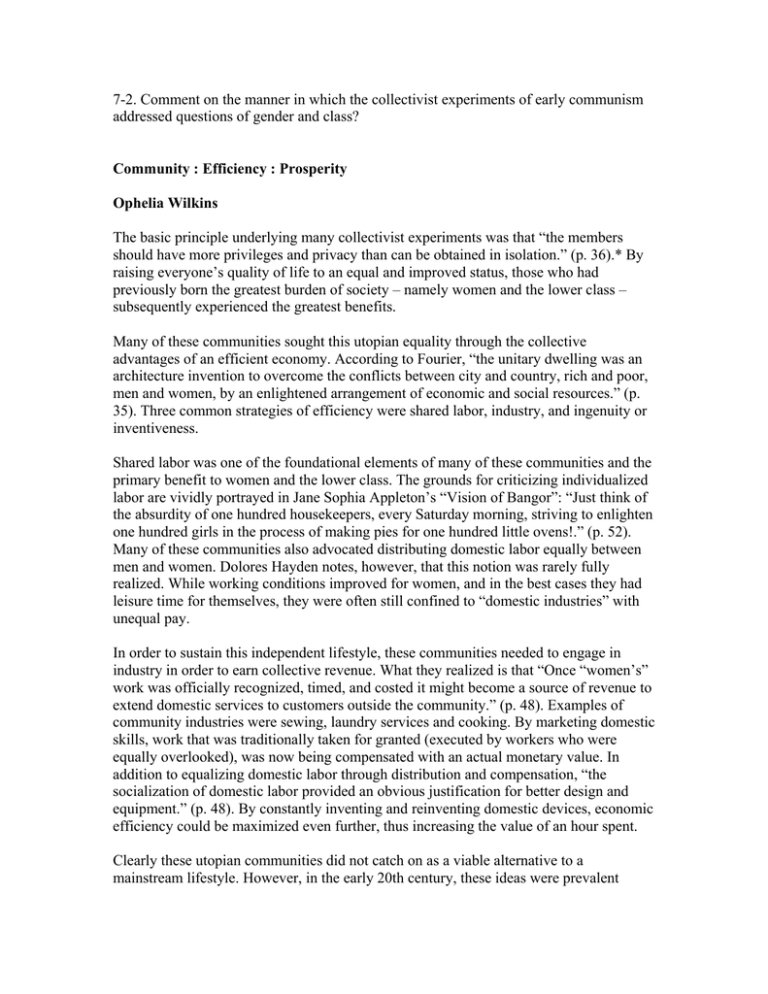7-2. Comment on the manner in which the collectivist experiments... addressed questions of gender and class?
advertisement

7-2. Comment on the manner in which the collectivist experiments of early communism addressed questions of gender and class? Community : Efficiency : Prosperity Ophelia Wilkins The basic principle underlying many collectivist experiments was that “the members should have more privileges and privacy than can be obtained in isolation.” (p. 36).* By raising everyone’s quality of life to an equal and improved status, those who had previously born the greatest burden of society – namely women and the lower class – subsequently experienced the greatest benefits. Many of these communities sought this utopian equality through the collective advantages of an efficient economy. According to Fourier, “the unitary dwelling was an architecture invention to overcome the conflicts between city and country, rich and poor, men and women, by an enlightened arrangement of economic and social resources.” (p. 35). Three common strategies of efficiency were shared labor, industry, and ingenuity or inventiveness. Shared labor was one of the foundational elements of many of these communities and the primary benefit to women and the lower class. The grounds for criticizing individualized labor are vividly portrayed in Jane Sophia Appleton’s “Vision of Bangor”: “Just think of the absurdity of one hundred housekeepers, every Saturday morning, striving to enlighten one hundred girls in the process of making pies for one hundred little ovens!.” (p. 52). Many of these communities also advocated distributing domestic labor equally between men and women. Dolores Hayden notes, however, that this notion was rarely fully realized. While working conditions improved for women, and in the best cases they had leisure time for themselves, they were often still confined to “domestic industries” with unequal pay. In order to sustain this independent lifestyle, these communities needed to engage in industry in order to earn collective revenue. What they realized is that “Once “women’s” work was officially recognized, timed, and costed it might become a source of revenue to extend domestic services to customers outside the community.” (p. 48). Examples of community industries were sewing, laundry services and cooking. By marketing domestic skills, work that was traditionally taken for granted (executed by workers who were equally overlooked), was now being compensated with an actual monetary value. In addition to equalizing domestic labor through distribution and compensation, “the socialization of domestic labor provided an obvious justification for better design and equipment.” (p. 48). By constantly inventing and reinventing domestic devices, economic efficiency could be maximized even further, thus increasing the value of an hour spent. Clearly these utopian communities did not catch on as a viable alternative to a mainstream lifestyle. However, in the early 20th century, these ideas were prevalent enough that many city planners incorporated principles of communal living into their utopian plans. For example, all three planners we looked at in class during the “Industrial Cities” week provided for certain shared spaces and tasks. Most notably, housing in Le Corbusier’s Villa Contemporaine would be communally owned by the inhabitants and services would be provided collectively. Corbusier’s justification (or postrationalization?) for dividing the housing by social class is that through these communal services, everyone’s quality of life would be greatly improved as compared to their current lives and what they could achieve on their own. * * All quotes from Dolores Hayden, “Socialism in Model Villages.” * Le Corbusier reference from: Fishman, Robert, Urban Utopias in the Twentieth Century: Ebenezer Howard, Frank Lloyd Wright and Le Corbusier, Cambridge, MA: The MIT Press, 1982. Economy and Efficiency James Smith In most collectivist experiments the isolated environment of traditional domestic housework found in single family, private dwellings was replaced with a model of social labor. Domestic work became the “dynamic centers of the villages.” (39) Shared labor, in which men and women contributed to domestic, industrial and agricultural work at certain times of the day, played a large role in the increasing efficiency of labor, resulting in increased dependence for women. Domestic efficiency and the end of domestic confinement were two of the goals of the collectivist experiments of communitarian socialists. “By combining the labor of many workers, male and female, they proposed to end the isolation of the individual farmer, industrial worker, and housewife, improving efficiency through division of labor while keeping all individuals involved with these areas of work.” (39) The communitarian socialists developed a domestic model of architecture based on a social environment as opposed to a private environment. Gender and class roles were dissolved as a result of the social environment of the domestic space. John Gray suggested in 1825 in A Lecture on Human Happiness “equal rights for women” and “equal domestic work for men.” (35) Charles Fourier and his followers argued for an extension of women rights, claiming that a society which limits women to the private house and domestic labor is “inferior to one where men and women shared equally in human activities, and women enjoyed economic independence.” The basis of early collectivist experiments is based on Fourier desire to remove the private dwelling from the domestic sphere, replacing it with a community of collective facilities, resulting in “an architectural invention to overcome the conflicts between city and country, rich and poor, men and women, by an enlightened arrangement of economic and social resources.” (35) The collectivist experiments increased the efficiency of domestic work through the division of labor. This resulted in the development of innovative inventions dedicated to increasing the efficiency of domestic labor. Items such as “improved washing machines”, the common clothespin, a double rolling pin, conical stove, the flat broom, removable window sash, a window sash balancer,” were all the result of the inventiveness of the communitarian socialists. The resulting efficiency of domestic labor led to increased freedom for domestic workers, allowing for an increased ability for women to “develop their own interests such as reading, writing, participating in musical and theatrical performances, developing friendships, enjoying amorous relationships.” (49) In most collectivist experiments efficiency of domestic labor and dissolving the confinement of women in the domestic sphere were the two most prominent goals. Providing a collective architecture of domestic space resulted in social domestication, in which men and women share roles, women have more freedom, and economy and efficiency evolve the domestic environment. All quotes from: Hayden, Dolores: “Socialism in Model Villages,” Chapter 2 in, The Grand Domestic Revolution. Cambridge, MA: The MIT Press, 1982 Lilly Donohue Beginning in the early 1800’s, communist experiments in collective living began to aggressively challenge the traditionally established ideas of gender and class in Europe and the United States. The majority of these experiments were constructed with the goal to generate a model of living that would achieve equality for all of the members of the community, irrespective of gender and effectively collapsing any privileging of classes. In “The Grand Domestic Revolution”, Dolores Hayden identifies several of these experiments and highlights the methods that were employed in an effort to achieve this reformed social structure, indicating that “…reformers believed that the construction of an ideal community would transform the world through the power of its example.” (p.33) Most of these communities rejected the perceived torture of the domestic labor traditionally assigned to women. In order to relieve them of overwhelming tasks such as housework and childcare, a shift from the private household to a communal household was proposed. The degree of reform and level of shared living was realized with some variety depending on the collective. This is evident both in the general strategies of the different groups, (which range from merely lifting a small amount of the woman’s labor by introducing shared childcare, to John Gray’s more radical proposal of equal rights for women as well as equal domestic work for men), and in the architectural propositions put forward. Some of the architectural solutions, such as those built for the Social Palace in France, retained private quarters for each individual family, yet provided options for collective dining and child-care. The Shaker community adopted a much more radical notion of shared space, resulting in dormitory bedrooms and completely common cooking, dining, and living quarters. While some degree of success was achieved in providing an equalizing of classes and some relief of the oppression of domestic work for women inside of these communities, they had little impact on the larger culture of Europe and the United States. Many of these communities, such as the Shakers, closely tied moral and religious reform to these broader issues of gender and class. It is true that many women were afforded more leisure time provided by sharing duties such as home keeping and child rearing. However, in many communities religious and moral doctrines dictated a mode of living centered on tremendous restraint and deprivation, privileging endless labor over resting or education. This proposed way of life was so rigid, restrictive, and segregated according to gender that despite the many advances realized in design and technology by this socialization of labor, ultimately it was impossible to apply to a larger population and in many cases was responsible for the eventual destruction of the communities themselves. * many facts from Dolores Hayden, “Socialism in Model Villages”




